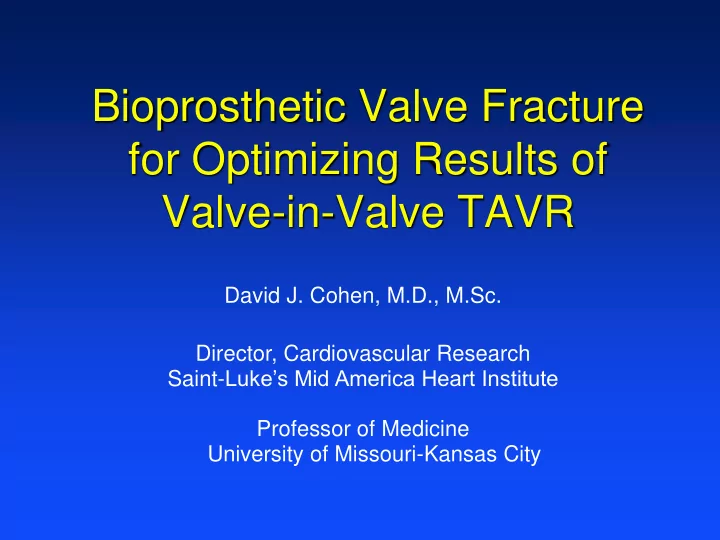

Bioprosthetic Valve Fracture for Optimizing Results of Valve-in-Valve TAVR David J. Cohen, M.D., M.Sc. Director, Cardiovascular Research Saint- Luke’s Mid America Heart Institute Professor of Medicine University of Missouri-Kansas City
Disclosures Grant Support/Drugs – Daiichi-Sankyo - Merck – Astra-Zeneca Grant Support/Devices – Edwards Lifesciences - Abbott Vascular – Medtronic - Boston Scientific – Biomet - CSI Consulting/Advisory Boards – Medtronic - Astra-Zeneca – Edwards Lifesciences - Cardinal Health DJC: 6/17
Valve-in-Valve TAVR ➢ VIV TAVR is an effective alternative to redo surgery in high or intermediate risk patients with failing tissue valves. ➢ However, VIV TAVR can be problematic with small surgical bioprostheses because of further reduction in the effective orifice leading to high residual gradients.
Impact of Surgical Valve Size on 1-Year Mortality VIVID Registry • 459 pts with failed surgical bioprostheses treated with ViV TAVR (59% balloon expandable, 41% self-expanding) • Patients stratified based on size of original surgical valve ‒ Small ≤ 21 (n=133) ‒ Medium 22-24 (n=176) ‒ Large ≥ 25 (n=139) • Small surgical valve independently associated with 1- year mortality (HR 2.04, p=0.02) Dvir D, et al. JAMA 2014;312:162-170
Patient P.M. • 71 y.o. man with bioprosthetic valve degeneration • Underwent AVR/CABG x 3 in 2007 (19 mm Magna) • Did well until late 2015 when he began to notice increasing DOE and fatigue • Echo: normal LV and RV size, LVEF 65%, aortic valve gradient 60 mmHg (peak 79 mmHg) with trivial AI • Referred for redo AVR vs. TAVR felt to be high risk due to patent grafts and proximity of RV to sternum ViV TAVR #19 Magna Valve: True Internal Diameter 17 mmHg Planned for 23 mm CoreValve EVOLUT
Baseline Hemodynamics Mean gradient = 63 mmHg AVA 0.8 cm2
Valve Implant (23 mm CoreValve EVOLUT)
Post-TAVR and Post-Dilation Mean gradient = 44 mmHg AVA 1.0 cm2
In-Lab Conversation (Paraphrased) • IC : This isn’t good. We still have almost as high a gradient as when we started • CTS : I know how to treat this. We can break the surgical valve. • IC : What??? Are you crazy? • CTS : I heard about it at a meeting recently. A surgeon from LA said he had done it a few times • IC: Really? I still think you’re crazy. Just like when you told us that transcarotid TAVR was a good idea.
Here’s what you’ll need… • 1 True Dilatation or ATLAS-GOLD Balloon • 1 60 cc luer lock syrine filled with dilute contrast • 1 PTCA indeflator • 1 high-pressure stopcock * Disclaimer: This is 100% off-label use and requires exceeding balloon RBP considerably
And here’s the set - up… 1 2
High pressure post-dilation 20 mm Tru Balloon
BVF: More Photogenic Example Final Appearance (1 week f/u)
Post- 20 mm Tru Balloon (16 atm) Mean gradient = 18 mmHg AVA 1.9 cm2
And here’s how it works… Nielsen-Kudsk JE, et al. Circ Cardiovasc Intv 2015
Final Appearance (1 week f/u)
Valves that can and cannot be fractured To date, the only valves that cannot be fractured are: Trifecta (St. Jude) Hancock II (MDT)
BVF Clinical Series • 20 consecutive patients* from 7 US centers treated with bioprosthetic valve fracture at the time of ViV TAVR (8 at MAHI) • Mean age 76 years; mean STS-PROM 8.4% • Valves treated: Mitroflow, Perimount, Magna/Magna- Ease, Biocor Epic/Epic-Supra, and Mosaic • Treated with both self-expanding (n=12) and balloon expandable (n=8) TAVR valves • 15/20 underwent BVF after TAVR valve deployed * 30 cases in full series as of 6/11/17 Chhatriwalla A, et al. Circ Intv 2017 (in press)
Mean Gradient 100 P<0.001 Mean Gradient (mmHg) 80 42 ± 11 P<0.001 60 21 ± 7 40 7 ± 4 20 0 Baseline Post-TAVR Post-BVF Chhatriwalla A, et al. Circ Intv 2017 (in press)
Effective Orifice Area (AVA) 3.5 P<0.001 3.0 Aortic Valve Area (cm2) 1.8 ± 0.6 P<0.001 2.5 2.0 1.0 ± 0.4 1.5 0.6 ± 0.2 1.0 0.5 0.0 Baseline Post-TAVR Final Baseline Post-TAVR Post-BVF Chhatriwalla A, et al. Circ Intv 2017 (in press)
Intentional Fracture of Bioprosthetic Valves • For patients with small bioprosthetic valves who are high risk for re- do AVR, BVF may offer a “solution” to high residual gradients after ViV implantation • Bench testing demonstrates that most surgical valves can be fractured (except Trifecta and Hancock II) • Clinical experience to date suggests that BVF is safe • Unresolved questions – Timing of BVF (pre vs. post-TAVR) impact on safety and long-term TAVR valve durability – Should all ViV procedures undergo BVF (even with a low gradient) to allow for better TAVR valve geometry and function
Acknowledgements- MAHI TAVR Team • Keith Allen, MD • Adnan Chhatriwalla, MD • David Cohen, MD MSc • Anthony Hart, MD • Suzanne Baron, MD MSc • Sanjeev Aggarwal MD • Michael Borkon, MD • John Saxon, MD
Recommend
More recommend